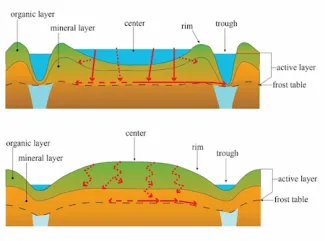Understanding Vertical and Horizontal Flow in Ice-Wedge Polygons
- This work, led by Nathan Wales (LANL) sought to better understand the relative roles of vertical and horizontal water fluxes in the subsurface of polygonal landscapes, providing new insights and data to test and calibrate hydrological models.
- Field-scale investigations were conducted at an intensively instrumented location on the Barrow Environmental Observatory (BEO) near Utqiaġvik, AK.
- Using bromide as a hydrologic tracer, Wales and his colleagues investigated a low-centered and a high-centered polygon.
- Ice-wedge polygons occupy large areas of the Arctic coastal plain.
- The future of these landforms in a warming climate depends on the bidirectional feedback between the rate of ice-wedge degradation and changes in hydrological characteristics.
- The low-centered polygon exhibited higher flow velocities and more fast flow paths than the high-centered polygon, where limited breakthrough occurred.
- Subsurface lateral flow is strongly influenced by frost table topography.
- Substantial differences in tracer behavior between the low- and high-centered polygons are represented in a newly developed conceptual model of active layer flow paths.
- Apparent horizontal hydraulic conductivities were found to be of the same magnitude as vertical conductivities for fast flow paths, highlighting that flow is not consistent with the 1-D downward flow assumption used in some polygon modeling approaches.
- The overall tracer mass recoveries were low, suggesting that tracer transport through bulk soil was much more limited than in the preferential flow paths.
- Data collected just before freeze-up and just after thaw suggests that transport over the winter period was important, resulting in significant changes in tracer concentrations at multiple locations.
- These results will prove useful in developing the next generation of hydrology models for tundra landscapes.
Wales N, JD Gomez-Velez, B Newman, CJ Wilson, B Dafflon, T Kneafsey, and SD Wullschleger. 2019. Understanding the relative importance of vertical and horizontal flow in ice-wedge polygon landscapes using tracers. Hydrology and Earth System Sciences 24:1109-1129. https://doi.org/10.5194/hess-24-1109-2020
This research was supported by the Director, Office of Science, Office of Biological and Environmental Research of the US Department of Energy under Contract No. DE-AC02-05CH11231 as part of the Next-Generation Ecosystem Experiments (NGEE Arctic) project.
For more information, please contact:
Brent Newman


